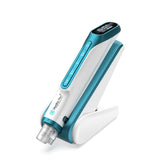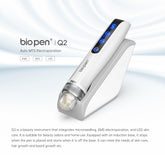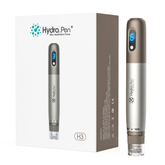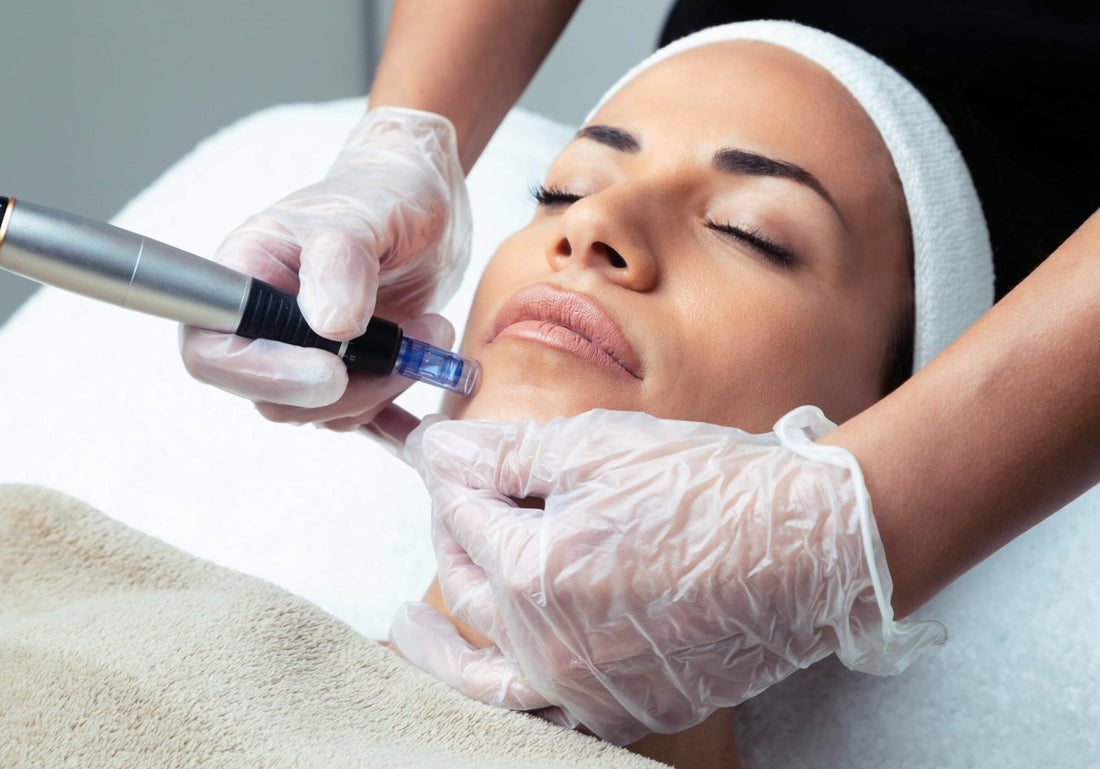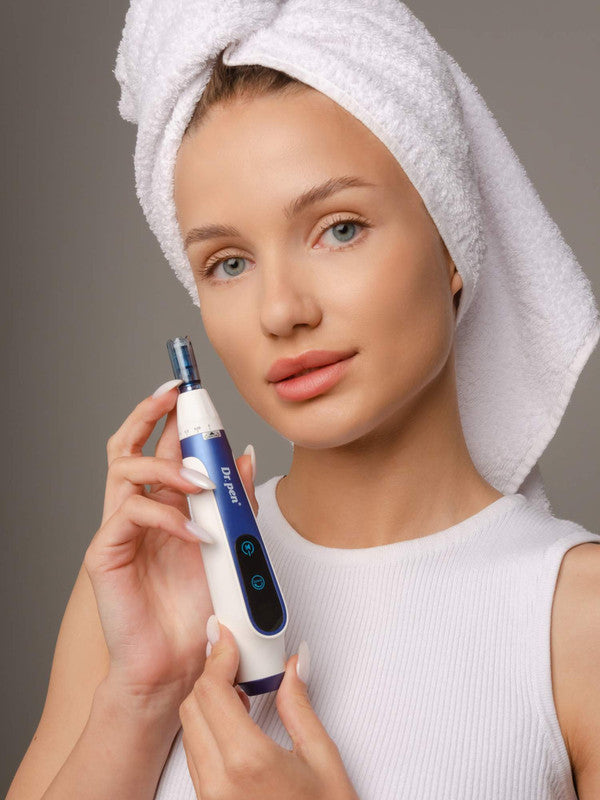If you consider yourself a skincare junkie, there’s a high possibility you’ve heard of microneedling and the benefits you can reap from this treatment. But did you know that pairing your treatments with a serum infused with the right ingredients can considerably improve the benefits of microneedling?
Microneedling is a skincare treatment where you use a derma roller or a dermapen to create deliberate wounds on the skin with tiny needles to stimulate collagen production. Through monthly treatments, derma rollers and dermapens can improve the appearance of fine lines and wrinkles, hyperpigmentation, and scarring, while also firming and brightening your complexion.
There's a couple of reasons for why we suggest microneedling with a serum. By pairing your treatment with a serum you may find it more comfortable during the actual treatment, as the serums will help your device glide over the skin more smoothly. Secondly, it also improves product absorption by up to 300%, helping you get the most out of your serums ingredients and resulting in a brighter complexion!
Please keep in mind that not all serums are suitable for microneedling. Some may cause irritation and should be avoided! We don't recommend needling with vitamin C or retinoids, or anything containing acids. Please patch test all serums before use. With any skincare concerns, please contact a health professional for advice before use.
So now that you know the benefits of needling with a serum, you're probably wondering which serums you should actually be looking at using.
It's best to apply your serum within 5 minutes of finishing needles, as this is the time of which micro-channels will still be open.
Keep reading for our suggestions on the best serum ingredients to use while microneedling.
Hyaluronic Acid
Once again, HA is your best friend! An extremely popular skincare ingredient which features in many moisturisers and serums, hyaluronic acid is also an amazing serum for microneedling.Hyaluronic acid is a hydrating ingredient which replenishes skin, and the micro-channels created during the microneedling process will optimise product absorption to maximise the benefits of any hyaluronic acid-based serum applied post-needling. Learn more about hyaluronic acid in our recent blog post, here.
It's best to ensure hyaluronic acid is the main player in your serum of choice, and your formula is fragrance-free to minimise the risk of irritation.
Peptides
Peptides help the skin remain intact by keeping the skin firm, reducing the appearance of wrinkles, and boosting overall texture and tone.
Therefore, by applying a peptide infused serum while microneedling you will concentrate their effects from vastly improved absorption.
As with hyaluronic acid, always choose a fragrance-free formula to avoid any potentially reactive ingredients.
Ceramides
Ceramides make up 50% of the uppermost layer of your skin and are the fatty acids which help keep the skin barrier intact and hold onto moisture. Needling with ceramides will assist with speedy healing through restoration and hydration, essential for during and after your treatment when your skin is feeling tight and flakey from the deliberate trauma.
EGF
EGF (epidermal growth factor) is used in medicine to speed up wound recovery, and also has multiple benefits for skin, including reducing the appearance of wrinkles, improving hydration, and preventing hyperpigmentation.
EGF stimulates growth at a cellular level to healing and restore damaged skin. It works by binding to cells and signalling them to behave like young, healthy cells, to grow, repair, and survive. This basically means cells will heal quicker and stronger.
If you’re noticing signs of aging, dry skin and uneven skin tone from hyperpigmentation, scarring and blemishes, EGF will help stimulate collagen and elastin to improve your skin texture and elasticity. With new cells, the skins barrier is strengthened, which means it can hold onto moisture and prevent melanin production during wound healing. This means a reduction in red marks left behind from breakouts.
Our bodies naturally produce EGF, but as with all good things, the production decreases with age, which slows down the speed at which the skin can repair itself. If you’re noticing early signs of aging in your skin, it’s probably a good time to start incorporating EGF into your routine. You might want to do so earlier if you find your skin experiences scarring or red marks after breakouts.
Apply EGF serum during and after needling, and as mentioned before, ensure your product doesn't contain any fragrances or active ingredients which may cause irritation. As always, check with a health professional if you're unsure of any ingredients or for any skin concerns.
We hope you enjoyed this read and now feel comfortable choosing your own serums to accompany your treatments. If you enjoyed this blog, you might like to read some of our previous entries. Click here to see other skincare related articles.
Microneedling is a skincare treatment where you use a derma roller or a dermapen to create deliberate wounds on the skin with tiny needles to stimulate collagen production. Through monthly treatments, derma rollers and dermapens can improve the appearance of fine lines and wrinkles, hyperpigmentation, and scarring, while also firming and brightening your complexion.
There's a couple of reasons for why we suggest microneedling with a serum. By pairing your treatment with a serum you may find it more comfortable during the actual treatment, as the serums will help your device glide over the skin more smoothly. Secondly, it also improves product absorption by up to 300%, helping you get the most out of your serums ingredients and resulting in a brighter complexion!
Please keep in mind that not all serums are suitable for microneedling. Some may cause irritation and should be avoided! We don't recommend needling with vitamin C or retinoids, or anything containing acids. Please patch test all serums before use. With any skincare concerns, please contact a health professional for advice before use.
So now that you know the benefits of needling with a serum, you're probably wondering which serums you should actually be looking at using.
It's best to apply your serum within 5 minutes of finishing needles, as this is the time of which micro-channels will still be open.
Keep reading for our suggestions on the best serum ingredients to use while microneedling.
Hyaluronic Acid
Once again, HA is your best friend! An extremely popular skincare ingredient which features in many moisturisers and serums, hyaluronic acid is also an amazing serum for microneedling.Hyaluronic acid is a hydrating ingredient which replenishes skin, and the micro-channels created during the microneedling process will optimise product absorption to maximise the benefits of any hyaluronic acid-based serum applied post-needling. Learn more about hyaluronic acid in our recent blog post, here.
It's best to ensure hyaluronic acid is the main player in your serum of choice, and your formula is fragrance-free to minimise the risk of irritation.
Peptides
Peptides help the skin remain intact by keeping the skin firm, reducing the appearance of wrinkles, and boosting overall texture and tone.
Therefore, by applying a peptide infused serum while microneedling you will concentrate their effects from vastly improved absorption.
As with hyaluronic acid, always choose a fragrance-free formula to avoid any potentially reactive ingredients.
Ceramides
Ceramides make up 50% of the uppermost layer of your skin and are the fatty acids which help keep the skin barrier intact and hold onto moisture. Needling with ceramides will assist with speedy healing through restoration and hydration, essential for during and after your treatment when your skin is feeling tight and flakey from the deliberate trauma.
EGF
EGF (epidermal growth factor) is used in medicine to speed up wound recovery, and also has multiple benefits for skin, including reducing the appearance of wrinkles, improving hydration, and preventing hyperpigmentation.
EGF stimulates growth at a cellular level to healing and restore damaged skin. It works by binding to cells and signalling them to behave like young, healthy cells, to grow, repair, and survive. This basically means cells will heal quicker and stronger.
If you’re noticing signs of aging, dry skin and uneven skin tone from hyperpigmentation, scarring and blemishes, EGF will help stimulate collagen and elastin to improve your skin texture and elasticity. With new cells, the skins barrier is strengthened, which means it can hold onto moisture and prevent melanin production during wound healing. This means a reduction in red marks left behind from breakouts.
Our bodies naturally produce EGF, but as with all good things, the production decreases with age, which slows down the speed at which the skin can repair itself. If you’re noticing early signs of aging in your skin, it’s probably a good time to start incorporating EGF into your routine. You might want to do so earlier if you find your skin experiences scarring or red marks after breakouts.
Apply EGF serum during and after needling, and as mentioned before, ensure your product doesn't contain any fragrances or active ingredients which may cause irritation. As always, check with a health professional if you're unsure of any ingredients or for any skin concerns.
We hope you enjoyed this read and now feel comfortable choosing your own serums to accompany your treatments. If you enjoyed this blog, you might like to read some of our previous entries. Click here to see other skincare related articles.




